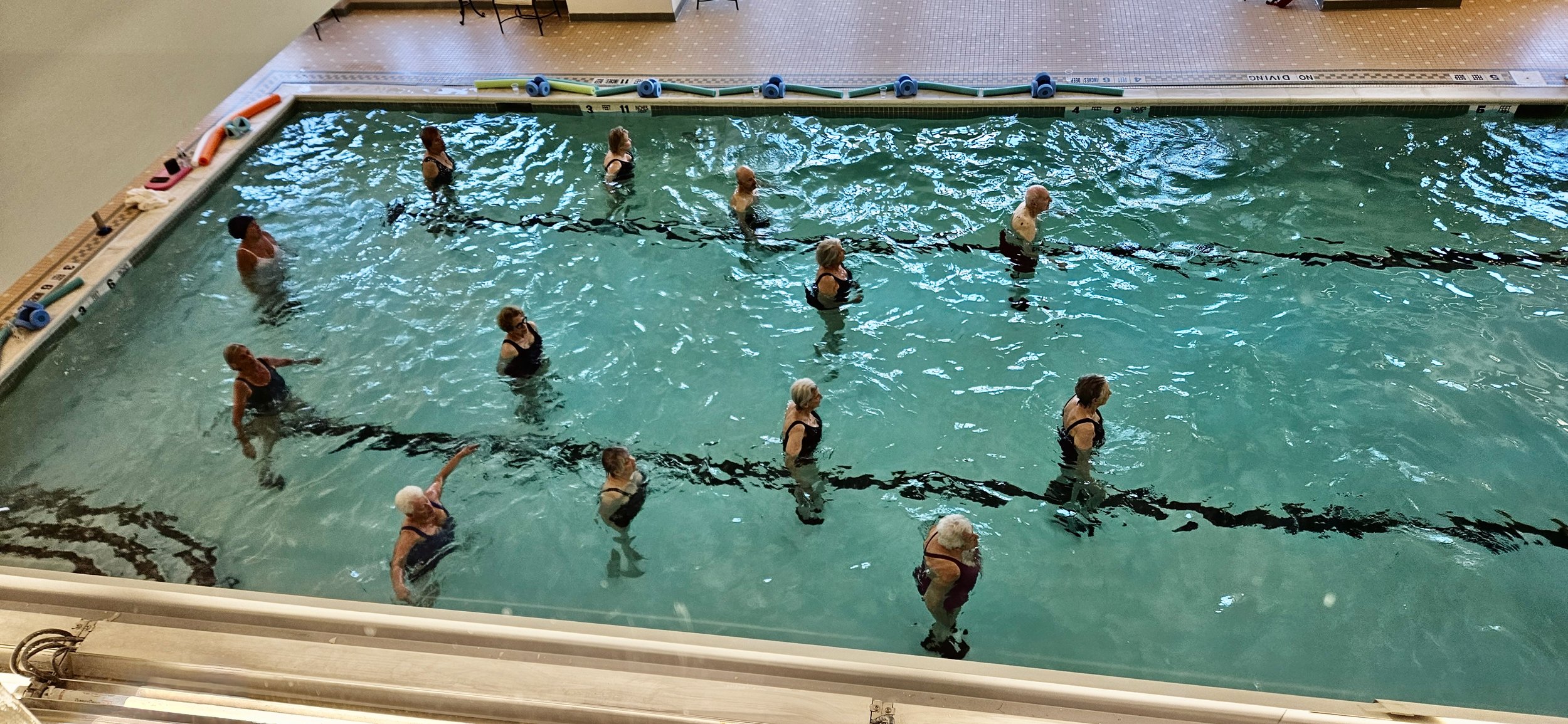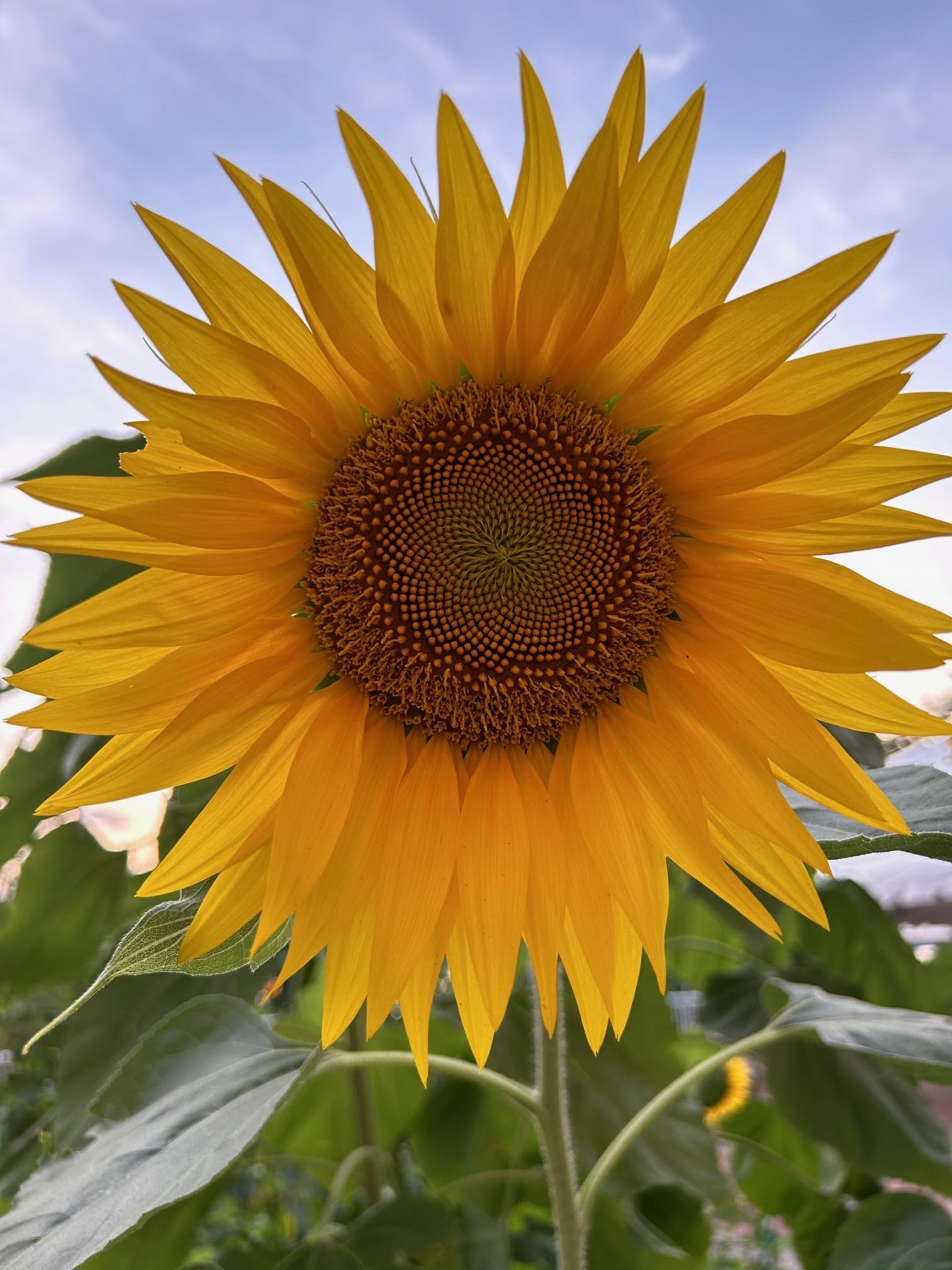Contributed by Donald Butt
Art by Sheila Benedis
Color Vibrations 2 Weaving
Art by Hart
Dr. Fisch’s advice was to cut back on the arugula
New sponsors and new cast, but “My Mother the Car” was back on air
The new girl group called themselves “5-Part Harmony”
The smallest compliment made Crumpleman blush
Lucinda had to tell everyone about the crazy dream she had last night — in detail
Art and photos by Jane Hart
In and Around Kendal
After the Storm . . .
Photo by Harry Bloomfeld
In Honor of a Lady
When Rockwood Park’s “Lady Tree” (aka Daphne) was destroyed last year by the high winds of a nasty storm, a new tree was planted in her honor. We’re glad to report that Daphne Jr. is thriving.
And we note, she now has her own plaque. . .
. . . though we await information from the parks service as to who, exactly, the honorable Florence Theresa Menninger Mooney was. Stay tuned.
Photos by Barbara Williams
A Cooling Walk in Rockwood Park
The Bridge to . . . ?
Still Waters
Portent of the Future?
Photos by Edward Kasinec
They’re B-a-a-a-a-ck
Yes, as predicted, they’re back in great numbers: the dreaded — and very hungry — lanternflies. They’re in the park, on the roads, on the terrace, and on Kendal’s windows. Remember: if you can reach ‘em, step on ‘em — do it with vigor! Ick!
Photo by Joe Bruno
Out and About
From the North Country
From Vermont: A Great Spangled Fritillary
Photo by Jane Hart
Made in NYC: Brands, Trends, and Inventions That Began in the Big Apple
GOODNIGHT MOON
Goodnight Moon has sold more than 50 million copies — it sells briskly today, nearly 7 decades after its initial publication. The book seems like it could be from England, or maybe even New England, but its origins are in a small farmhouse on 71st Street and York Avenue. (The house can be seen today in Greenwich Village, where it was moved in 1967.) “Cobble Court” was where author Margaret Wise Brown wrote Goodnight Moon. She drew on its interior for inspiration.
BLOOMINGDALE'S
The first Bloomingdale's goes back to the Civil War era and the Lower East Side. Immigrant Benjamin Bloomingdale and his son Lyman Bloomingdale founded it in 1861 as Bloomingdale’s Hoopskirts, with a focus on the then-trendy hoop skirt. Lyman and his brother Joseph had a sharp eye for growth opportunities and opened a second location in midtown — Bloomingdale’s Great East Side Bazaar — in 1872. Along the way, they pioneered the notion of a department store. In 1886 they established Bloomingdale’s at 59th and Lexington Avenue, the flagship headquarters the company retains to this day, along with 57 other locations.
BOAR’S HEAD PROVISION COMPANY
Boar’s Head has a national reach, showing up on grocery shelves and in deli cases all over. It sells over a billion dollars every year, but it began with humble Brooklyn roots. Frank Brunckhorst began distributing under the brand name in 1905, selling cold cuts and hot dogs in an effort to add more quality to Brooklynite plates. By 1933 Brunckhorst and his partners had launched their first small manufacturing plant in Brooklyn. (More than a century later the same families are still running the business, which advises you to “Compromise Elsewhere.”)
Source: “Made In NYC,” by Ethan Wolff, March 2024, City Guide New York
Contributed by Bobbie Roggemann
To be continued. Stay tuned for more.
Beat the Heat
Okay, so we have heat. Check. We have humidity. Check. We have a population over the age of consent. Check, double check, and check that sucker again. It’s now August and that means take those first couple of things — heat and humidity — and double down. Herein a chart to pay attention to. Check it on a regular basis until, say, the snow starts to fall:
And should you be in Tarrytown and things just get too hot for comfort, here are places to go to take a break.
Don’t be shy. Don’t be stubborn. Be wise. Get cool!
I Never Knew That
Rats Bop Their Heads in Time to Music
Just can’t stop yourself. The song starts playing and your toe starts tapping. And you might even start bopping your head. Well, in the animal kingdom, you’re not alone . . .
Most rats live their lives entirely unseen by humans. As kings of the background, they often scurry through human environments just out of sight or after dark, looking for leftover morsels. But researchers believe rats might be picking up more than just our food crumbs — they could also be picking up on the beats in our music. A study published in 2022 suggests rats may have a humanlike sense of rhythm, which they express by bopping their heads to the beat. Scientists once believed that few animals were beat-sensitive (aside from some birds), but rats exposed to music made microscopic head movements that were picked up by tiny, wireless motion detectors. The researchers hypothesized that rats would prefer faster jams thanks in part to their rapid heartbeats, though surprisingly, lab rats synced up best with music in the 120 to 140 beats-per-minute range — just like humans.
Humans have long wondered if animals respond to music the way we do. Charles Darwin’s studies examined the relationship between animals and music, believing rhythm could be found throughout nature and may have been the precursor to music. Today, some experts believe only certain species have the ability to really respond to changing beats — notably bats, birds, dolphins, and elephants, which all have the complex ability to learn and repeat new sounds. However, some studies show other animals interact with music, too; one experiment found that pigs exposed to certain music became playful and wagged their tails. Additionally, many farmers report their cows are calmer when the radio is on, with a supporting study reporting that dairy cows produce 3% more milk while listening to slow tunes (fast music had no effect). And when it comes to our best pet companions, music is known to soothe anxious dogs in shelters and adoption centers, though felines — known for being a bit finicky — couldn’t care less about human music. However, they do respond positively to tailored tunes that use beats and frequencies similar to their own meows.
Source: interestingfacts.com
Contributed by Jane Hart
The Grands
Mimi and Bob Abramovitz recently had a cherished set of visitors: their nephew, Josh, and their own set of Grands: Josh’s son Clay and daughter Ellita, all the way from Berkeley, CA. They all took to Kendal right away. Hang in there, kids, only about 60 years to go!
For Your Funny Bone . . .
Contributed by Donald Butt
Contributed by Barbara Bruno
Art by Hart
Ted, a burned-out Care Bear, was taking meds for his compassion fatigue
The neighborhood toughs were even meaner when Betty took Chufton to school in her doll carriage
Beryl kept her important stuff in a jar
Dobbin and Glenn were late entries at Saratoga
Thrilled with the bumper crop of new potatoes, Mr. PotatoHead could finally think about retiring
Art and photos by Jane Hart
Art by Sheila Benedis
Color Vibration 1
In and Around
A New Perspective
A Kendal Sunset: Southern View, over the Tappan Zee Bridge
Photo by Greg Lozier
Kendal Olympics
Hey, we’re not just pretty faces here at Kendal. We’re on our game, sports-wise, as well. So, herein some Kendal spot:
A Popular Sport
Photo by Joe Bruno
Bocce — and a good, long toss
Photo by Joe Bruno
When it’s too hot outside for Bocce . . . switch to corn hole tossing
Photo by Pete Roggemann
Awaiting a triathlon? Ya just never know . . .
Photo by Joe Bruno
How to Start the Day Out Right: A Morning Rainbow
Photo by Harry Bloomfeld
Blue Against the Gold
Photo by Edward Kasinec
Train Spotting, Kendal-Style: The Last in Over 100 Cars . . . NYC-Bound
Photo by Marilyn Bottjer
Peek-a-Boo!
Photo by Joe Bruno
July Birthdays
Photo by Harry Bloomfeld
“Do I Know You?”
Photo by Edward Kasinec
Out and About
Diversion Par Excellence
While biding her time in Phelps Hospital recently, Sarah Plimpton captured the storm that raced across the Hudson.
Discovering Noguchi
On July 24, Kendalites journeyed to NYC to visit the Noguchi Museum. A brief history of Isamu Noguchi, courtesy of Wikipedia and Art Brady:
Isamu Noguchi (November 17, 1904 – December 30, 1988) was an American artist and landscape architect whose artistic career spanned 6 decades, from the 1920s onward. Known for his sculpture and public artworks, Noguchi also designed stage sets for various Martha Graham productions, and several mass-produced lamps and furniture pieces, some of which are still manufactured and sold.
In 1947, Noguchi began a collaboration with the Herman Miller company when he joined with George Nelson, Paul László and Charles Eames to produce a catalog containing what is often considered to be the most influential body of modern furniture ever produced, including the iconic Noguchi table which remains in production today. His work lives on around the world and at the Isamu Noguchi Foundation and Garden Museum in New York City.
Art Brady also sent along photos from the Noguchi Museum, itself.
Made In NYC: Brands, Trends, and Inventions That Began in the Big Apple
Brooks Brothers
Brooks Brothers is the world's oldest clothing retailer. It's been in business since 1818, when Henry Sands Brooks opened H. & D.H. Brooks & Co. on the northeast corner of Catherine and Cherry Streets on the Lower East Side. He eventually turned the business over to his four sons, who changed the name and expanded. Among Brooks Brothers's innovations are the ready-to-wear suit, the first American button-down polo, and bringing the U.S. market the Shetland sweater, the Harris tweed, madras, argyle socks, and summer suits. The business managed to stay in family hands for more than a century, until 1946.
Televised Sports
Globally, televised sports are prominent in many cultures and account for a $60 billion dollar market. The beginnings trace back to the north end of Manhattan and Baker Field. Columbia University's home turf was the site of the first televised sporting event, on May 17, 1939, when Princeton traveled to Columbia for a baseball game. The National Broadcasting Company beamed the game out to the 400 or so sets that could receive the signal. They were happy enough with the results to try a pro game a few months later. Brooklyn was the location for that one, as the Reds took on the Dodgers at Ebbets Field on August 26th, 1939. It was the first pro sporting event to ever be televised.
Ralph Lauren Corporation
Ralph Lauren does about $6 billion in annual sales and employs 20,000 people around the world. Despite its preppy name, like so many American icons it began with a child of immigrants, in this case from the Bronx. (Ralph Lauren was born Ralph Lifshitz but changed his last name when he was 16, following his brothers, who also experienced bullying from it.) Lauren got his start with Brooks Brothers, as a tie designer, which helped him hone his classic American style. His company was founded in 1967 and remains headquartered in New York City.
Source: “Made In NYC,” by Ethan Wolff, March 2024, City Guide New York
Contributed by Bobbie Roggemann
Stay tuned for more! To be continued . . .
This Little Light of Mine, I'm Gonna Let It Shine . . . and Shine . . . and . . .
The world’s longest-burning lightbulb has been on since 1901.
Technology such as LED lighting has made lightbulbs last longer than ever, but no modern bulb even comes close to the incandescent Centennial Light, which has been glowing inside a fire station in the San Francisco Bay Area since 1901. The light shines for 24 hours a day, though it has taken a few breaks here and there for power outages, renovations, and venue changes. It was first installed in a cart house — so named when fire hoses traveled on carts, not trucks — but moved to a large firehouse nearby soon after. In 1903, it moved again to a newly built station. It stayed there until 1976, when it moved to its present home in Livermore, CA. At that point the bulb had been operational for 75 years and had become a sensation; it even got a police and fire truck escort for the journey, which was slightly less than 2 miles.
Unsurprisingly, the bulb’s survival probably boils down to good craftsmanship. The thick glass was hand-blown, and the bulb has a thick, durable carbon filament, unlike the thin tungsten filaments that became standard later. That was all mounted by hand on a sturdy brass base. Additionally, it’s filled with nitrogen gas, which is gentler than the argon and krypton gas used in later incandescents.
The second longest burning lightbulb, located in Fort Worth, Texas, was made by the same company, Shelby Electric.
The Centennial Bulb was hooked up to its own power source in 1976, and has lost power only once since then, for a little under 10 hours. Leaving it on 24/7 may have actually contributed to its longevity, since turning a bulb on and off frequently can damage the filament. The bulb also now burns at a steady 4 watts, much lower than its original 60 watts.
Source: historyfacts.com
Contributed by Jane Hart
I Never Knew That
Why “Kendal”? An Explanation by Norman Sissman.
Kendal, England, where it all began
For those of you who may not know it, our home was named after the town of Kendal, in the northwest part of England, near the Lake District. It was a frequent stop for George Fox (1624-1691) during his many proselytizing speaking tours aimed at recruiting members for his new sect, The Religious Society of Friends. This group was soon called Quakers, as they were said ”to tremble in the way of the Lord.”
One feature of the history of Quakerism was the persecution to which it was subjected throughout its history, at least until the 20th century. Although the reasons for this were many, I suspect that one of them was its abandonment of any clergy, which, of course, evoked a hostile response from priests, bishops (perhaps even rabbis). The persecution persisted even after many in England came to America.
My family vacationed often in Shelter Island which was named not only for its coves where ships could escape the fury of stormy seas, but also because it was a refuge for Quakers fleeing persecution by the Puritans of New England. Shelter Island even has a Fox Lane.
The most well-known American Quaker is William Penn. Penn’s efforts, in his state, to live amicably and justly with the local Native American population, were abandoned after his death.
The Mermaids Came, the Mermaids Came!
Saturday, July 20, starred mermaids of all sizes, ages, and ilk—with a few pirates thrown in, as well—for the first ever Sleepy Hollow Mermaid Festival, celebrating the Hudson River and 150 incorporated-town years. Two thousand people filled Kingsland Point Park for the fun and games in support of keeping our backyard neighbor — the mighty river we love — healthy and hearty. It all kicked off with the Mermaid Parade:
Neptune, of course, marched, too.
For Hudson Independent reporting on the day and many, many, many more wonderful pictures, click below.
The Grands
What could be better than a picture, a story, or a visit with The Grands — be they grandchildren, great grandchildren, great (or is it grand?) nieces and nephews? Barbara Bettigole’s “Great-Grand,” Sam, recently went on a canoe trip with his dad. Seems there were elk in the vicinity . . .
Contributed by Barbara Bettigole
Summer Vacation News
A Milestone to Celebrate
Mid-July Ginny and Bob Bender hit a special milestone: 55th years of wedded bliss. Their chosen way to celebrate: art in the middle of nature’s beauty, i.e. a trip to Storm King Art Center. And nature celebrated with them, providing a beautiful day after mid-summer heat extraordinaire.
The bride and groom
Photos by Ginny Bender
Berkshire Beauty
Meanwhile, Edward Kasinec took a visit to the Berkshires for beauty and inspiration.
Rattlesnake Mountain
Guan Yin, the Compassionate One
Photos by Edward Kasinec























































































